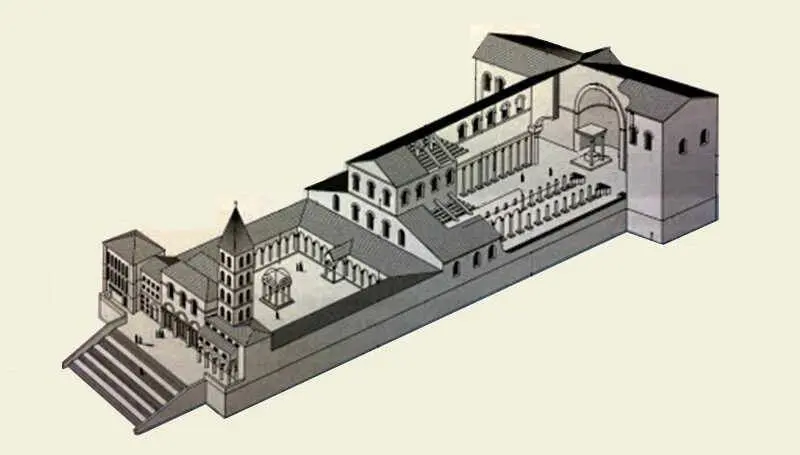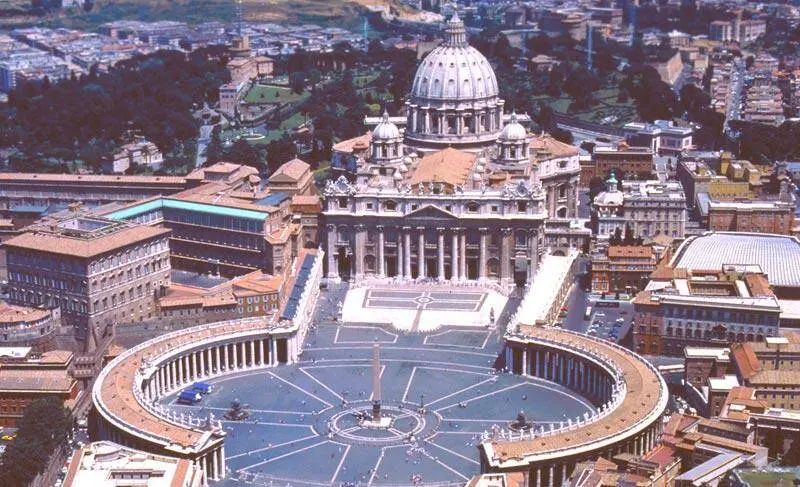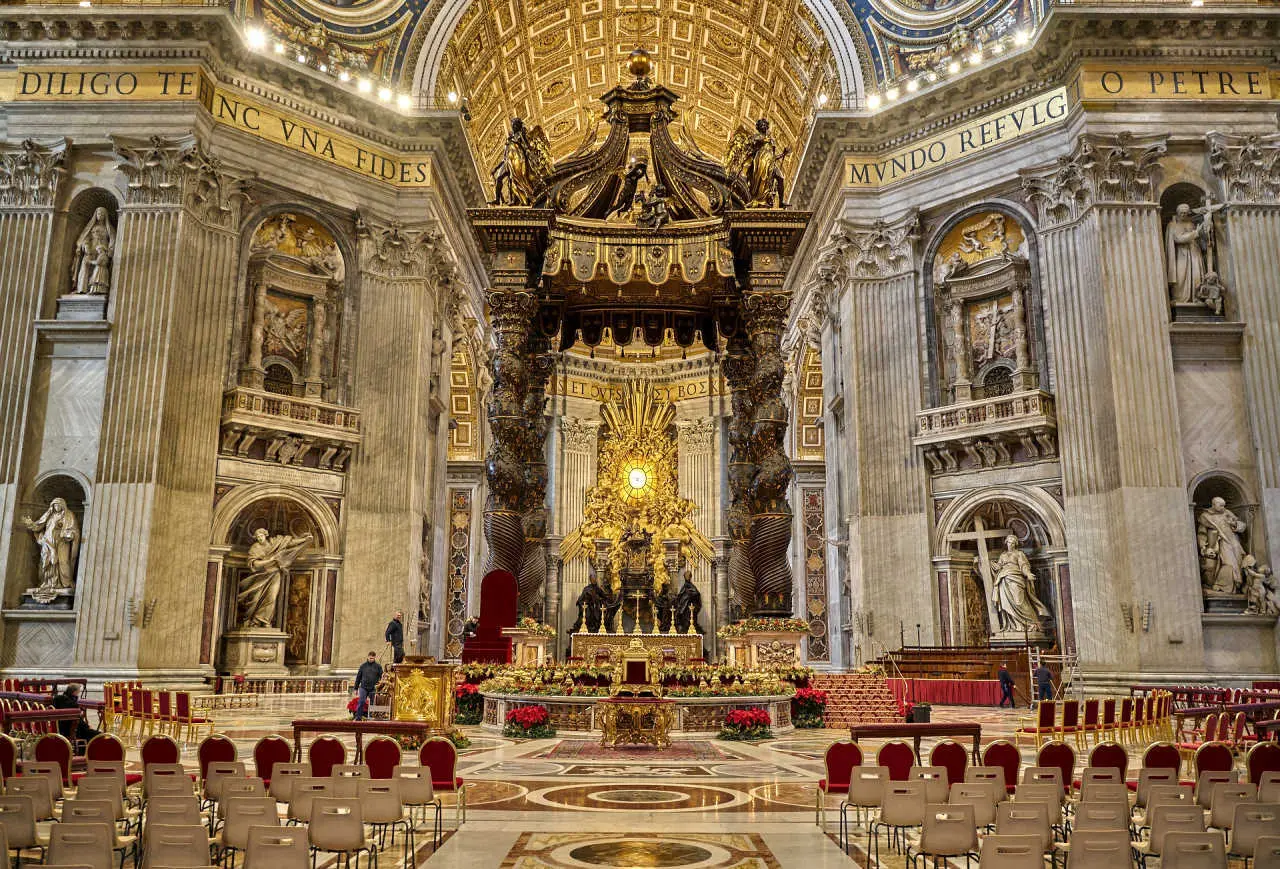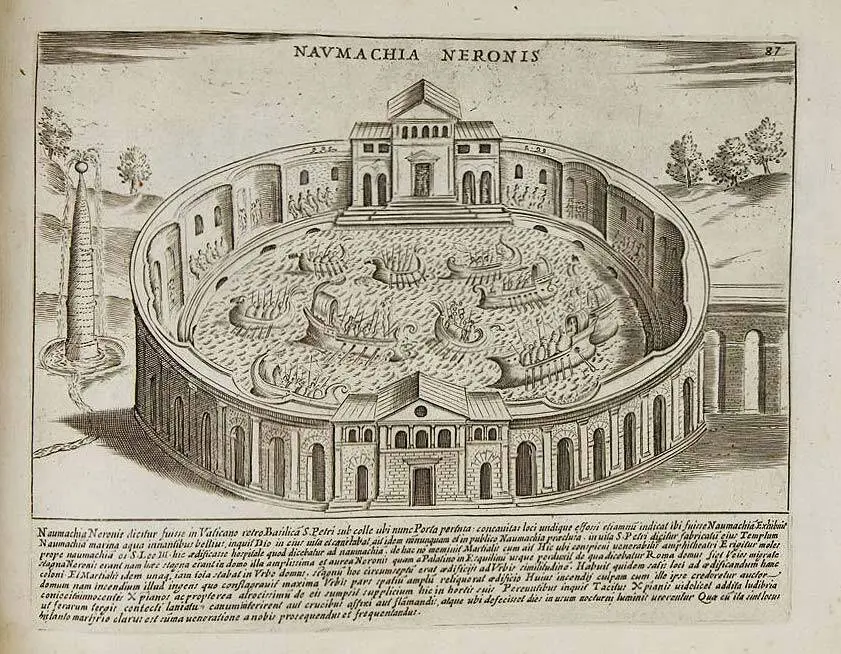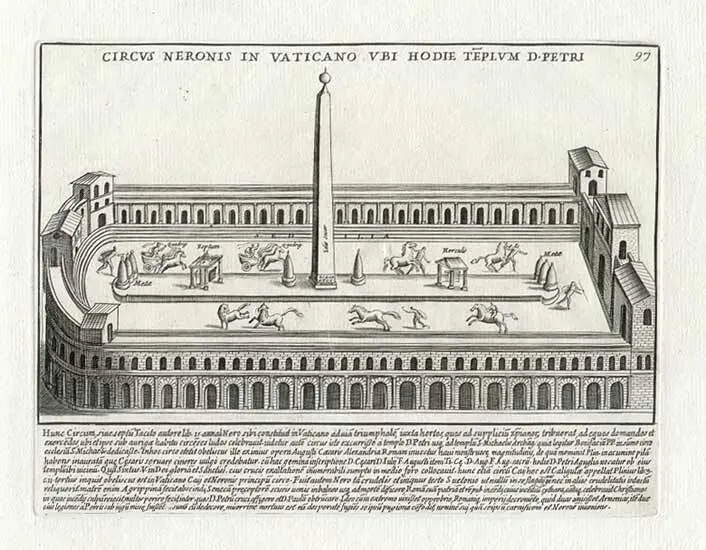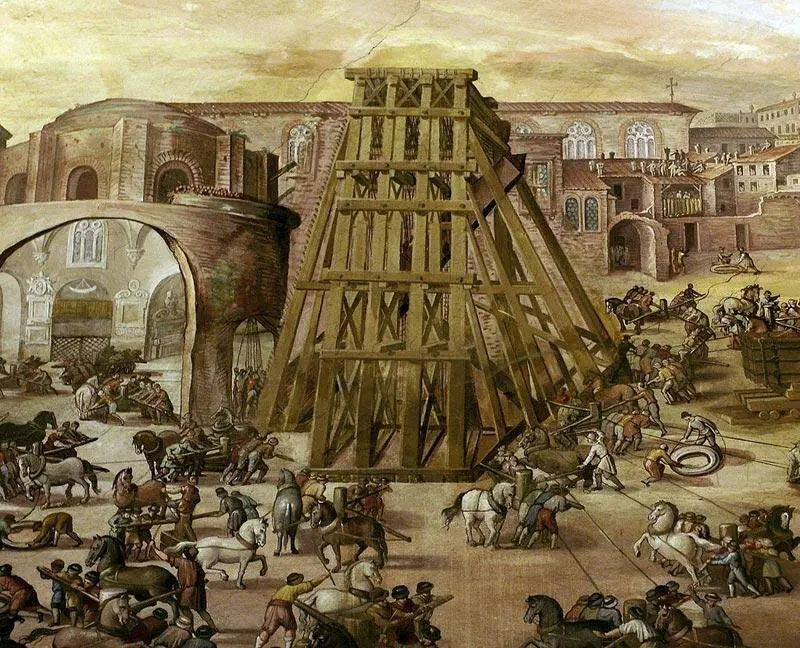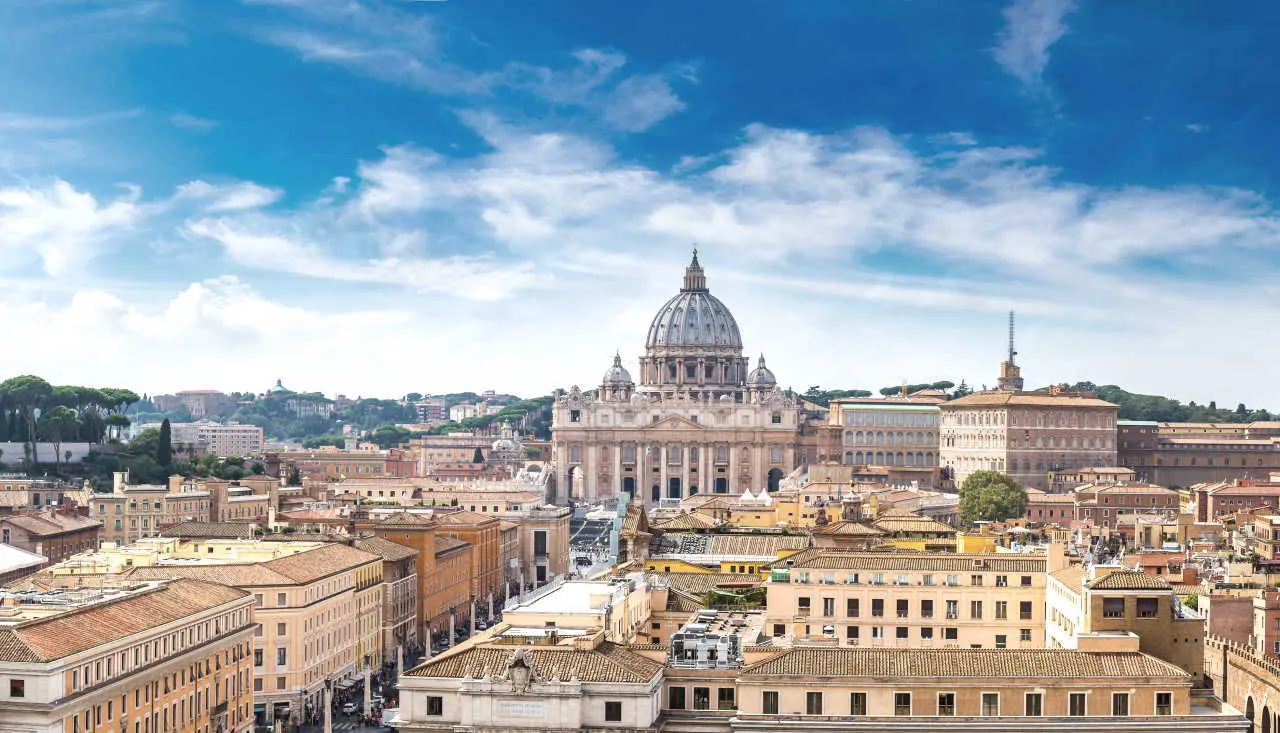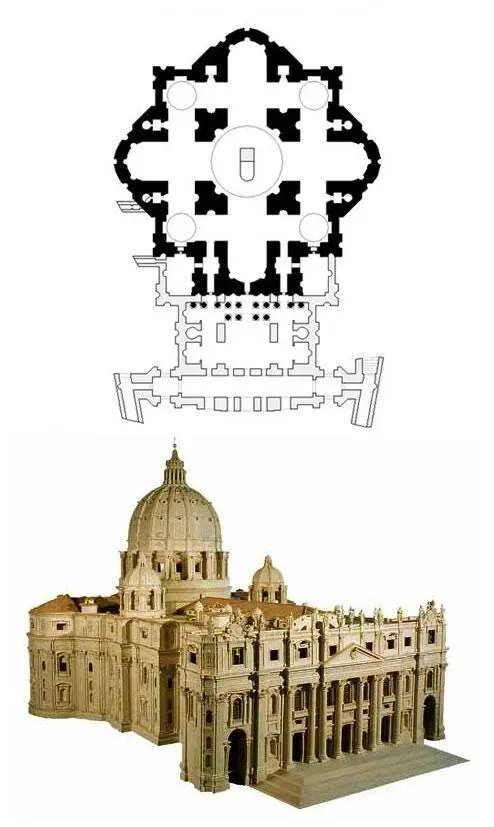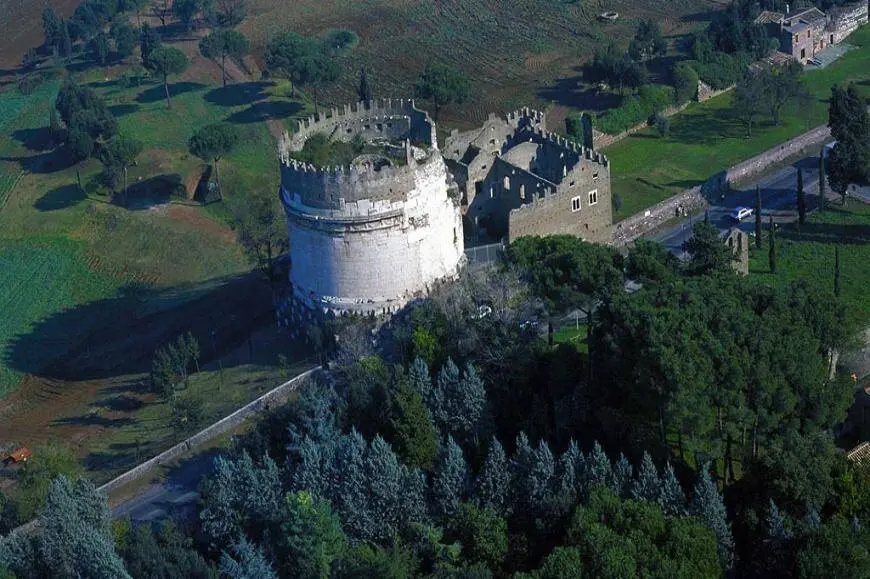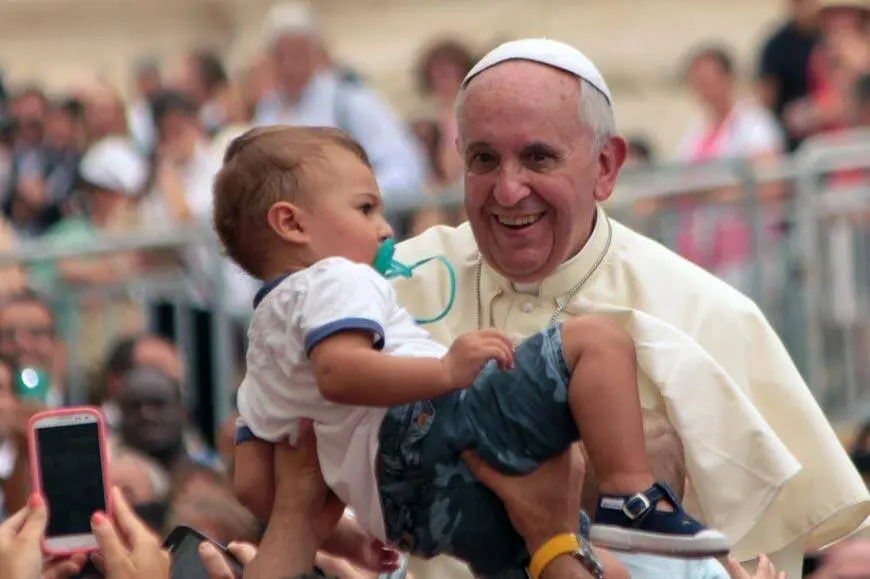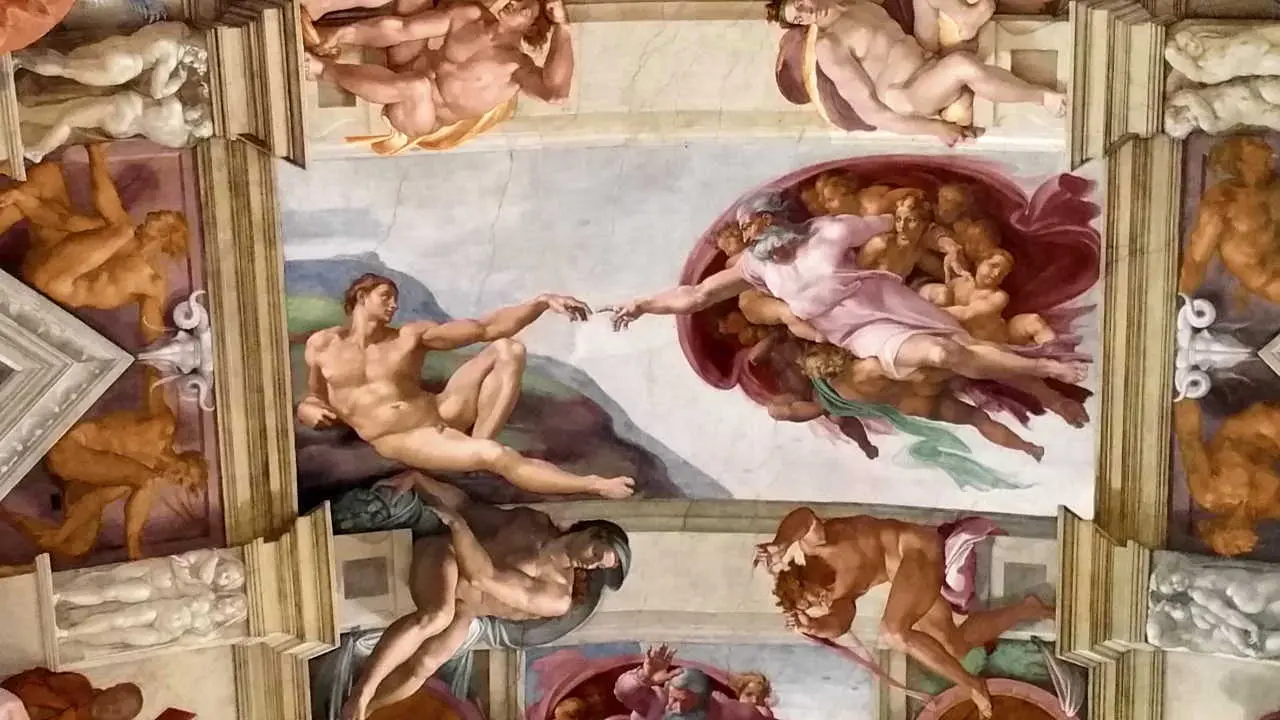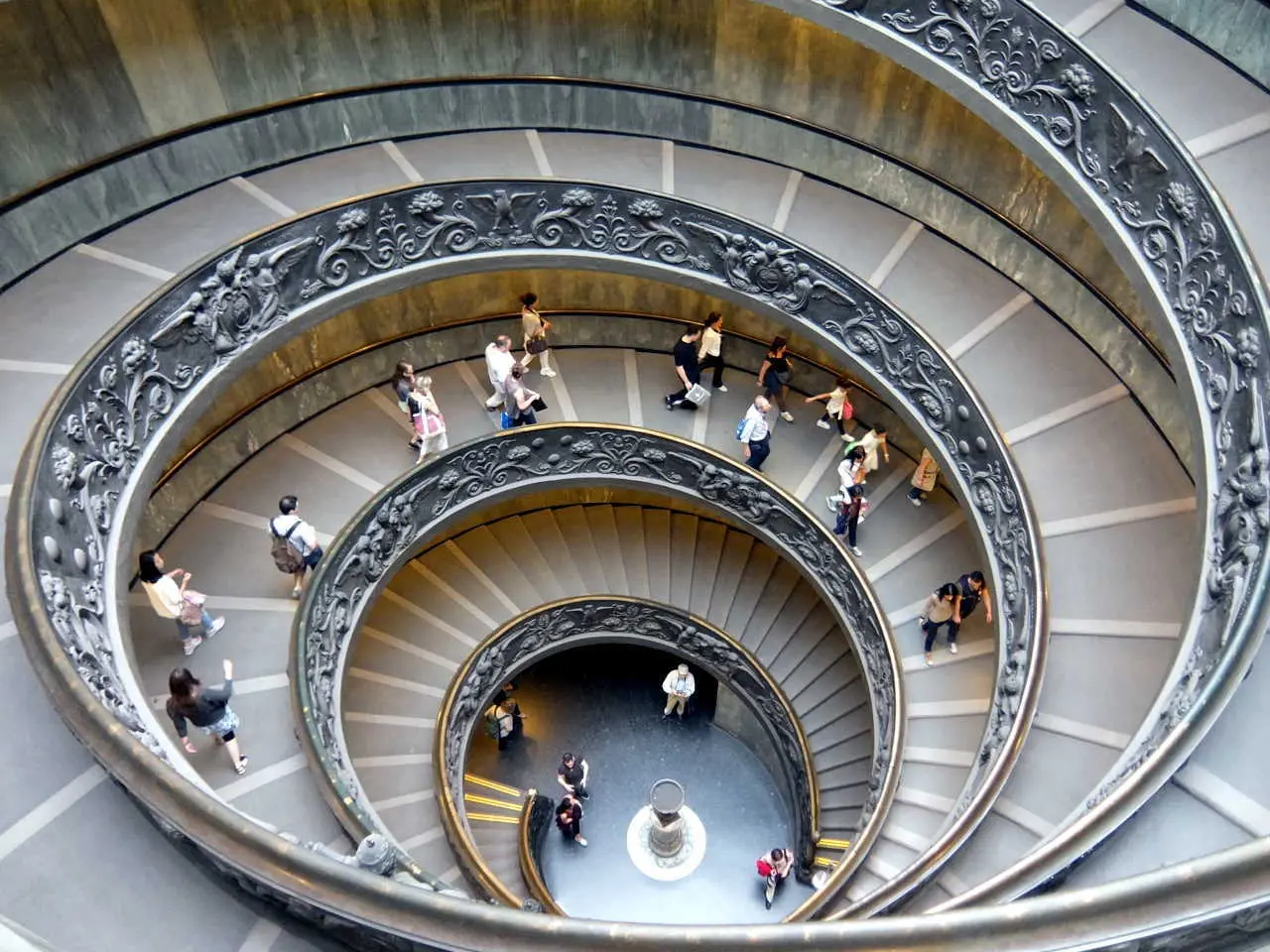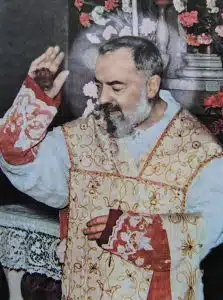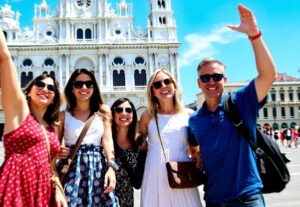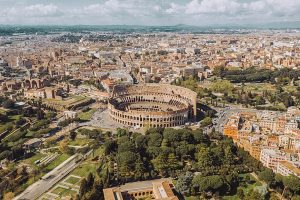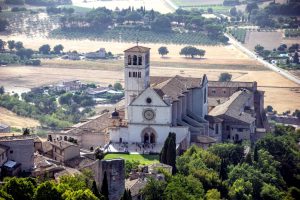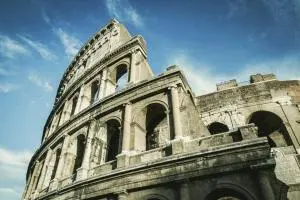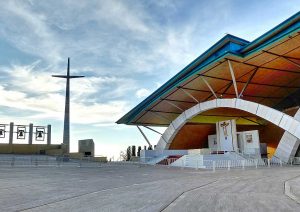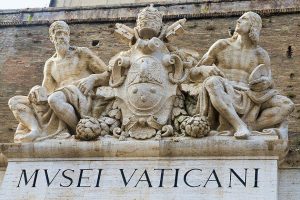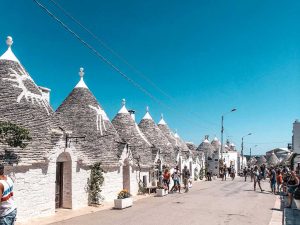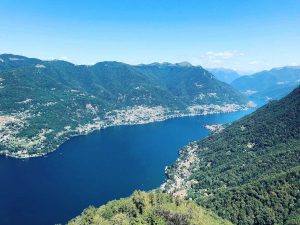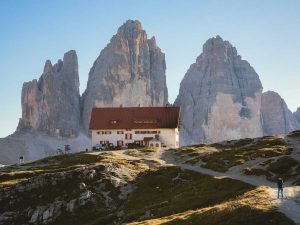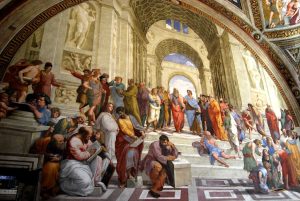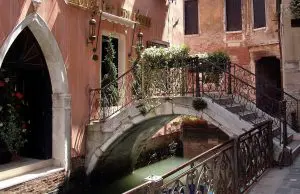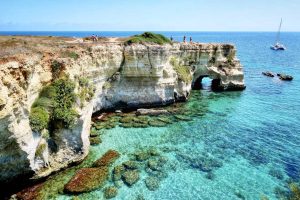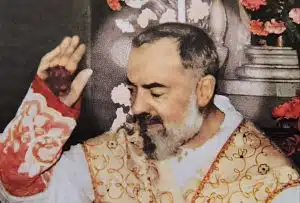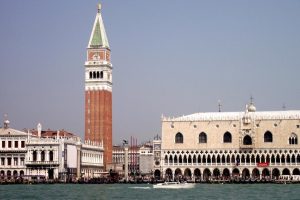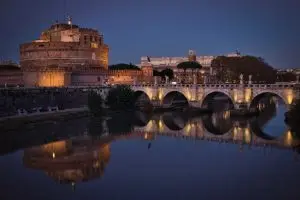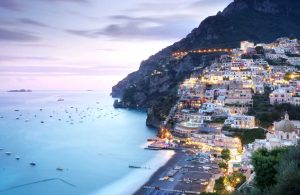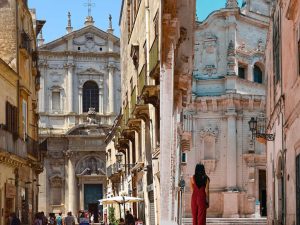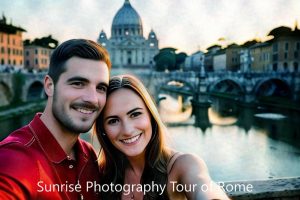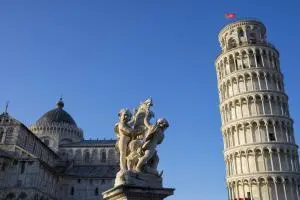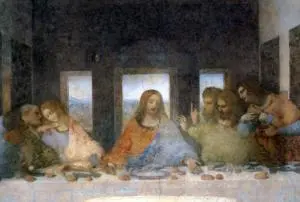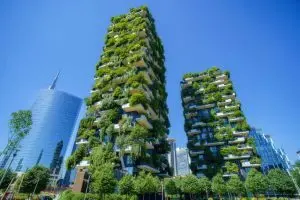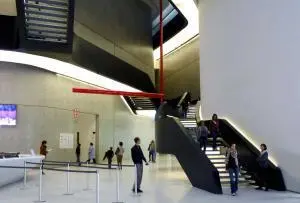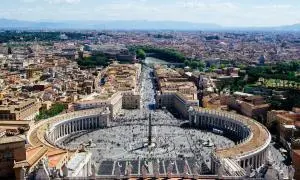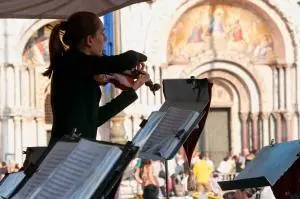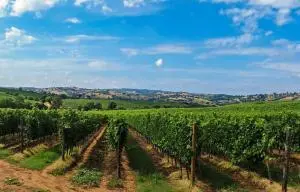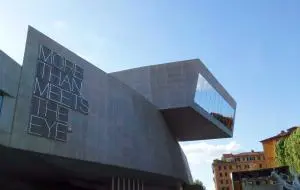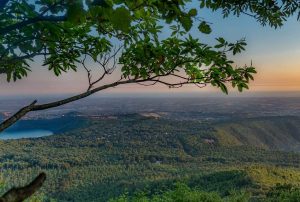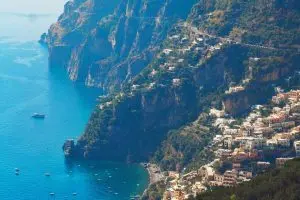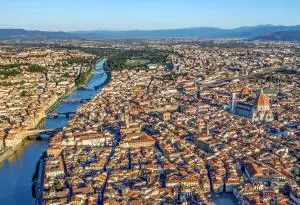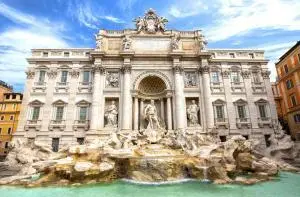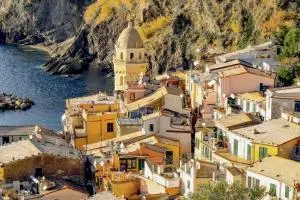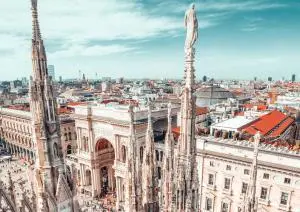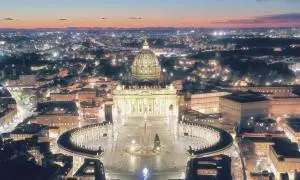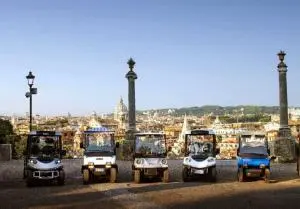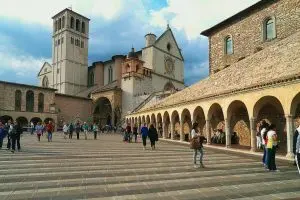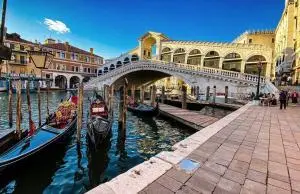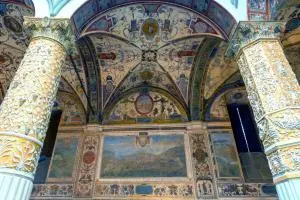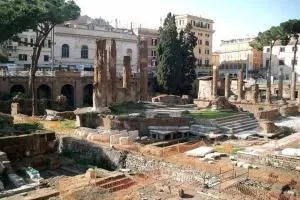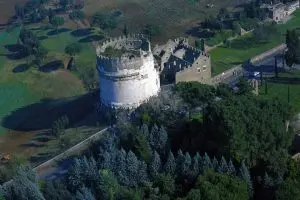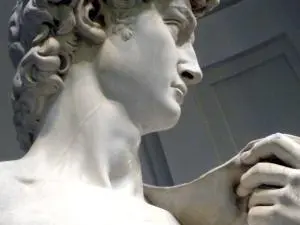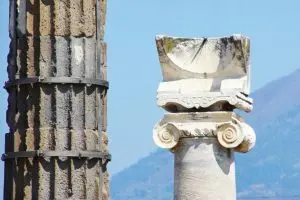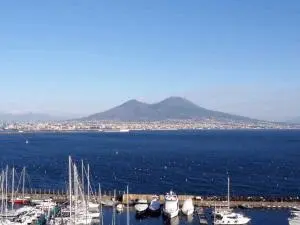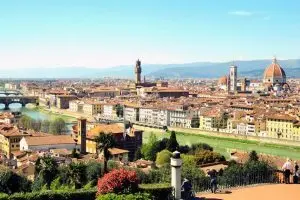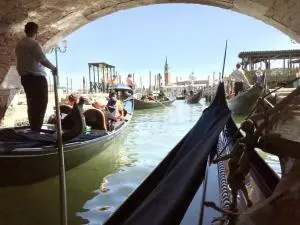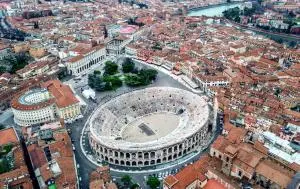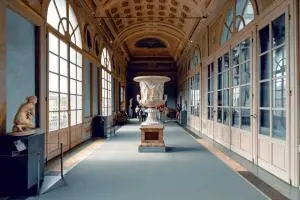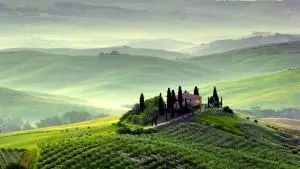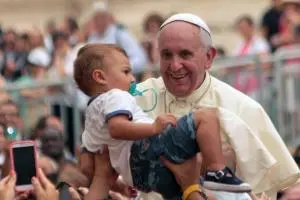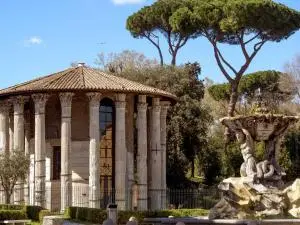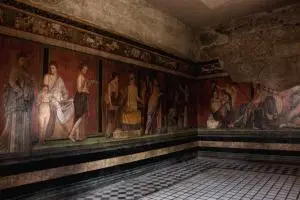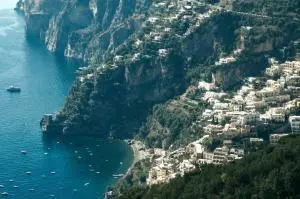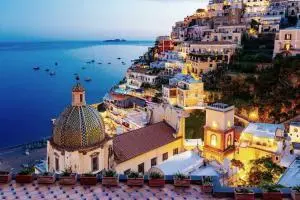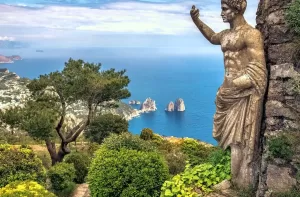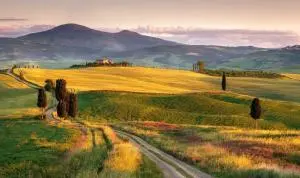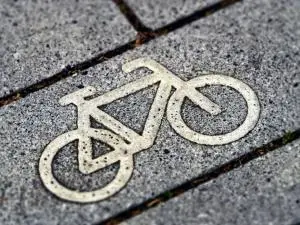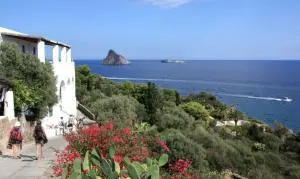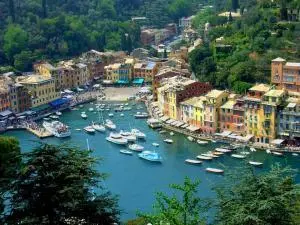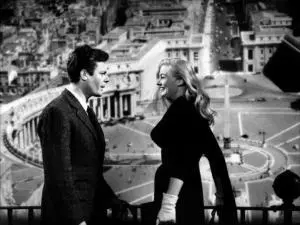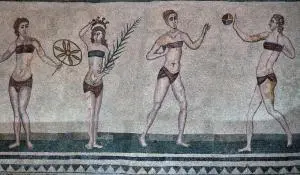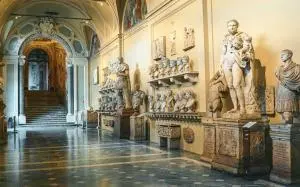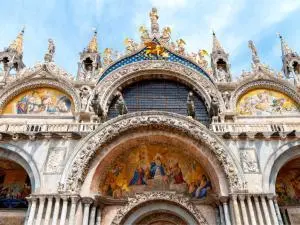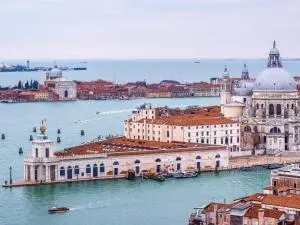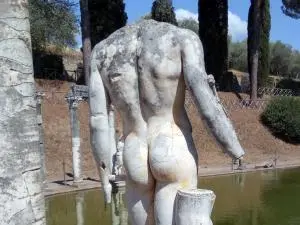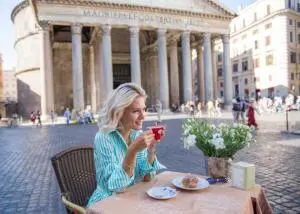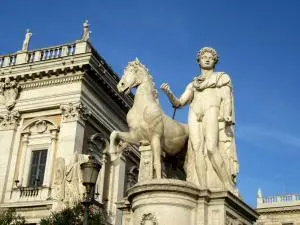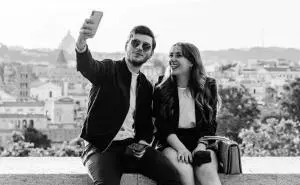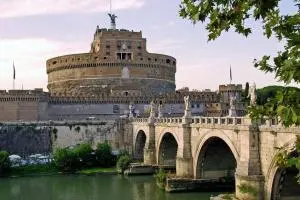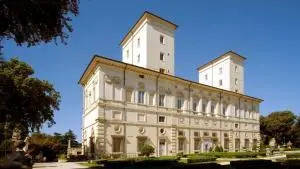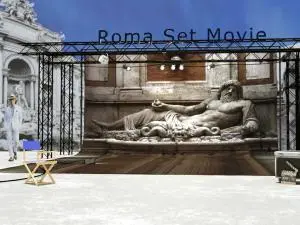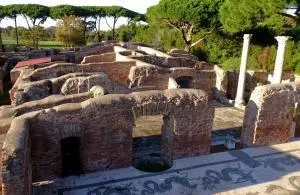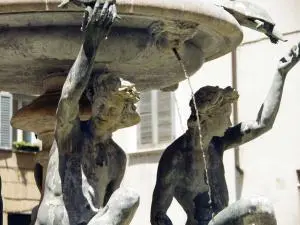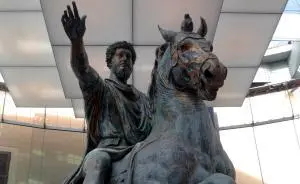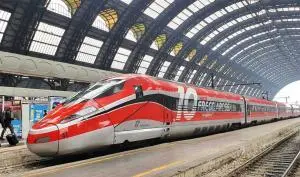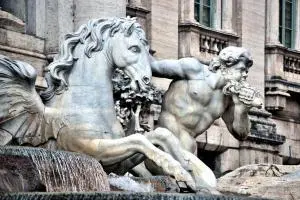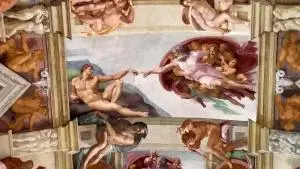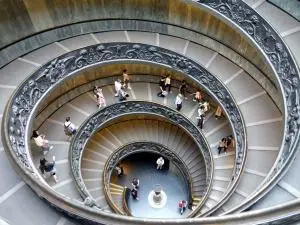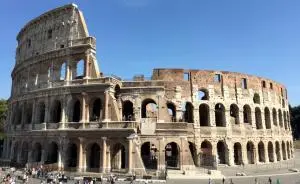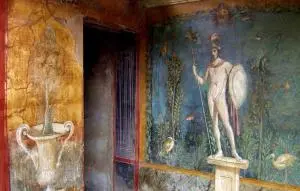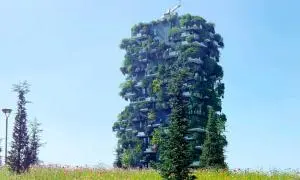The Basilica of St. Peter in the Vatican City
The Basilica of St. Peter is in the heart of the Vatican City, an independent sovereign state on the right bank of the Tiber river, in the centre of Rome
The Vatican State is the smallest State in the world, and what remains of temporal dominions of the Church, which were annexed to Italy at the end of 1800’s with the unification of the country
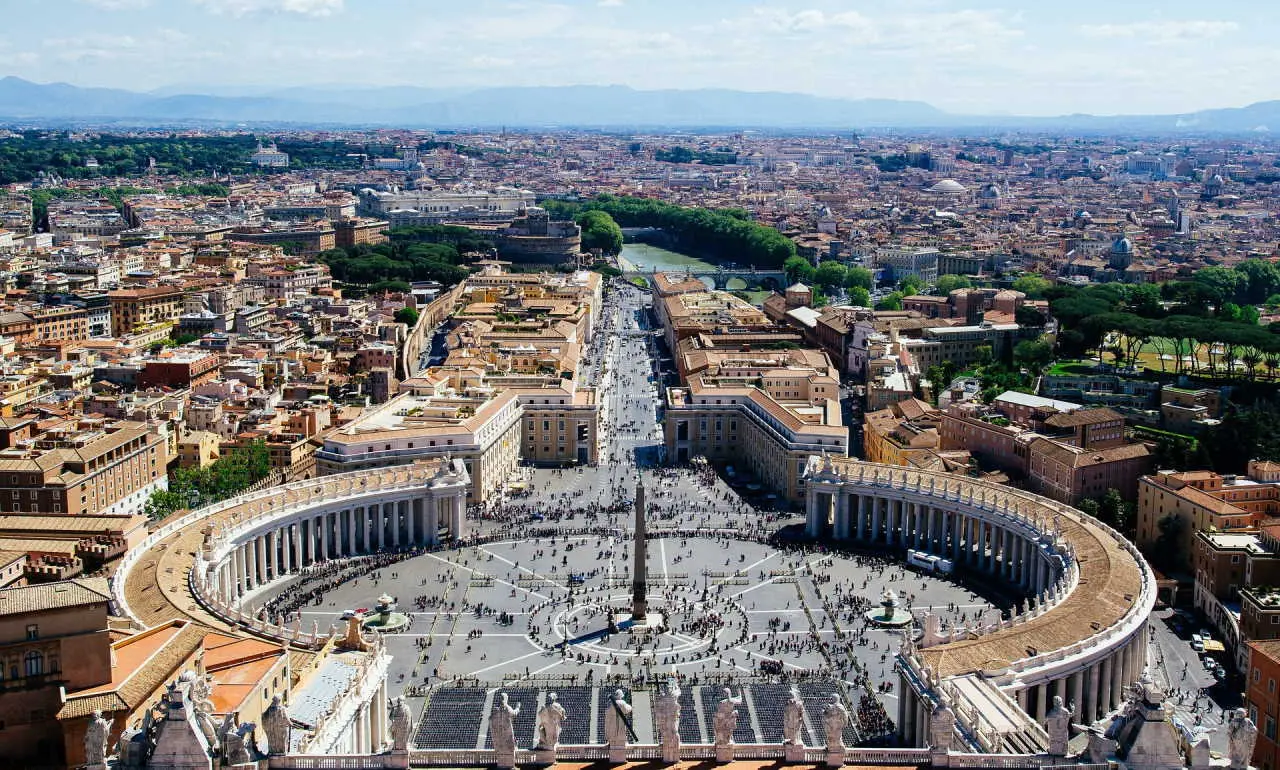
The Constantinian Era
St. Peter’s Square
St. Peter’s Square with its famous colonnade which represents one of the most brilliant ideas of Gian Lorenzo Bernini, is 320 meters wide with a central ellipsis of 240 meters and is surrounded by 4 rows of 284 columns and 88 pilasters. The balustrade above the columns is decorated with 140 statues of Saints. Below, a huge stairway of three flights flanked by the statues of Saint Peter and Saint Paul. In the centre of the square, there are two great fountains and an obelisk.
The Basilica
The façade of the Basilica -14.69 mt. wide and 47.3 mt. high – is made of travertine of Tivoli. It features a unique structure of Corinthian columns and frames a broad central portico with two arcades on either side (the one on the left leads to the City of the Vatican); above, nine balconies with windows (the central one is the loggia of the blessings) and a canonical attic surmounted by the balustrade that supports thirteen statues. Five bronze doors lead inside. In the middle of the church dominate the magnificent “dome” by Michelangelo and the smaller domes of the Gregorian and Clementine chapels.
Inside, the Basilica is 186 m long (218.7 with the portico, or front hall), the main nave is 46 m in height and the height of the dome is 119 m. Under the dome is the papal altar, with the famous canopy by Bernini rising over it. The sumptuousness of the interior is breathtaking: 45 altars, 11 chapels, around 10 thousand square metres of mosaics and many other masterpieces, such as the “Pietà” by Michelangelo. The tombs of several popes can be found under St. Peters Church.
Constantine, the first Christian Emperor, wanted the building of the Basilica in 315 AD exactly on the site where the tomb of Christ’s first Apostle was worshipped.
The origin
Originally the Vatican area was an unhealthy and uninhabited place. Its condition improved at the beginning of the 1st century when the area closest to the Tiber River was reclaimed.
Following works saw the creation of gardens, large parks, villas and outstanding buildings, such as Naumachia Vaticana, probably used for water games and the Mausoleum of Hadrian, today is known as Castel Sant’Angelo and the private circus of Caligula.
Along via Cornelia there were tombs, altars and sepulchres, in total respect of the Roman law that prescribed for all burial places to be located outside of residential areas.
Built by Emperor Caligula between 37 and 40 AD, the building was located on the left side of the current basilica, in the valley leading down to the river. The circus was the stage for the first persecution of the Christians by Nero.
The obelisk
The position of the circus has been known since at least the 1600’s, also due to the fact that the obelisk rising in the centre of the circus stood in its original place until 1586, when it was moved to the centre of St. Peter’s square upon orders of Sixtus V.
The event is reported by Domenico Fontana in his book, Della Trasportatione dell’Obelisco Vaticano et delle Fabriche di Nostro Signore Papa Sisto V, Roma 1590 (“about the transportation of the Vatican Obelisk and the works undertaken by His Holiness Sixtus V”).
The operation costed 40,000 scudi, 800 workers, 140 horses and 40 hoists; Sixtus V emanated an order with the death penalty for anyone who obstructed works, or even made noise: the lifting operations took place in absolute silence and had to be accompanied only by the sound of a trumpet. It is said that Fontana had his horse ready for the escape in case the obelisk had fallen during the operation. Fontana succeeded in his work also thanks to one of the workers, the sailor called Bresca, who seeing that the supporting ropes were about to break, broke the silence by shouting out “acqua alle funi!” (water to the ropes!).
The circus was already out of use one hundred and fifty years after its construction, at the time of Emperor Caracalla, when a large circular mausoleum was built above the circus not too far from the obelisk and later dedicated to St. Andrew.
Trasformations
The radical transformation of the entire Vatican area took place in the 4thcentury when Christianity rapidly took over pagan worship. After the abdication of Diocletian, responsible for the last great persecutions, the wars of succession to conquer the power ended with the nomination in 307 AD of Emperor Constantine.
Son of one of Diocletian’s generals, Constantine was recognised as Emperor in 312, after the defeat at Saxa Rubra, near Rome, of his rival Maxentius, on October 28th, who drowned in the Tiber river. The following year, the Emperor established the liberalisation of the religion with the Edict of Milan, ensuring that Christianity was no longer obstructed and could be worshipped freely. From then on, political and religious powers were no longer unified in the person of the Emperor, to the point where in 330 AD the capital was transferred to the East, leading to the founding of a city named after himself on the Bosphorus: Constantinople. He made Rome the religious centre of the Empire and for this purpose started an intense building program that had to give to the rising Church its worthy places of worship. The first building erected was the Basilica, in order to assure an adequate celebration of the prince of the apostles. The church of San Giovanni in Laterano followed, then the Papal residence and the Imperial Palace; followed by Santa Croce in Gerusalemme, San Pietro and Marcellino, San Sebastiano, San Lorenzo outside the walls and finally the church of Sant’Agnese.
St. Peter’s Basilica grew also thanks to works and donations made by princes and popes; in 800 Charles the Great was crowned by the Pope Leo III, after him was Lotario, Ludovico II° and Federico III°.
The “Fabrica di San Pietro”
At the beginning of the Early Middle Ages, the city of Rome went under a progressive decline, no longer the heart of a great Empire but the target for sacking by the Barbarians, by the Goths of Alarico (410) and by Vitige(537-538), by the Vandals of Genserico (445), who cut the aqueducts to bend the city and finally by Totila (545-546). One thousand years after its foundation, St. Peter’s was going to ruin and Niccolò V° decided to undertook extensive works of restoration upon suggestion of Leon Battista Alberti and the project of Bernardo Rossellino.
During the Renaissance in Italy and in Europe a new cultural and political climate was breathed, the rebuilding of Rome began (the urban situation of the period and the transformations) on the initiative of a new generation of popes who saw the building works as a means for reaching them asses that, Niccolò V°, the humanist pope, thought needed to be fascinated by grand works.
And so began the magnificent plan of Niccolò V, the restoration of ancient monuments that could be used as the infrastructure of the papal city: the Aurelian walls, the bridges, the Mausoleum of Hadrian transformed into a castle, several aqueducts, the reconstruction or repair of the forty basilicas making up the Holy Stations of pilgrimage and finally the creation of a small city on the Vatican hill, seen as a holy city different from the profane city, on the other side of the Tiber and connected only via the bridge of Castel S.Angelo.
Niccolò V only managed to complete a small part of his project. The new basilica was constructed by Giulio II Della Rovere. Works began with the demolition of a large part of the old church, following the project of Bramante, with the intention of building a Greek cross plan edifice inspired by the Pantheon. The central pillars of the design by Bramante were created, with the large support arches of the dome, and the spaces created adjacent to the central part, then works stopped for 20 years.
In 1527 there was the terrible sacking of Rome by the Lanzichenecchi. The direction of works was then continued – with strange and recurring competition between Greek cross plan and Latin cross plan – by Frà Giocondo, Raffaello, Giuliano da Sangallo, Baldassarre Peruzzi, Antonio da Sangallo il Giovane and finally Michelangelo, who re-applied the design of Bramante, restructuring the smaller areas surrounding the central part and beginning the construction of the dome, which was only completed under Sixtus V in 1593 by Giacomo Della Porta and Domenico Fontana. Under the pontificate of Paul V the decision was made to restore the basilica with the definite return to the Latin cross plan. Architect Carlo Maderno added three chapels to each side of the building and conducted the naves up to the current façade (begun in 1607 terminated in 1614 and restored on the occasion of the Jubilee 2000).
Maderno’s works was criticised by many because hiding from view the tambour, the rising effect of the dome is dampened. The consecration of the new basilica was celebrated by Urban VIII in November 1626. Upon conclusion of this grand work, the construction of the city was stopped, but the miraculous balance between ancient ruins and the Baroque scenes of papal Rome is so great that it has fascinated and enraptured great travellers such as Byron, Goethe, Stendhal…
Vatican City Tours
-
Ancient Basilicas and the Catacombs of Rome
Pilgrimages in Italy183,00€ – 408,00€Christian Rome and the Catacombs - Private tour, an itinerary retracing the history of Christianity in Rome
Rome | Private vehicle | Expert guide | 4 hours
Add to Cart This product has multiple variants. The options may be chosen on the product page -
Papal Audience with Pope Francesco
City Tours of Rome35,00€Every Wednesday morning the possibility to meet Pope Francesco at the Vatican
Vatican City | Ticket Papal Audience | Expert Guide | 4 hrs.
Add to Cart This product has multiple variants. The options may be chosen on the product page -
Private Tour Vatican Museums and Sistine Chapel
Private Tours of Rome141,00€ – 278,00€Skip the line Private Vatican Tour, a fascinating 3-hours itinerary to admire the masterpieces of the Vatican Museums, Sistine Chapel, St Peter’s Basilica
Rome | Walking Tour | Private Guide | 3 hrs.
Add to Cart This product has multiple variants. The options may be chosen on the product page -
Tour Vatican Museums and Sistine Chapel
City Tours of Rome164,00€Skip line Vatican Museums, Sistine Chapel and St Peter’s Square Tour, a fascinating itinerary on foot to the discovery of treasures of the Vatican State
Vatican Rome | Walking Tour | Expert Guide | 3 hrs.
Add to Cart This product has multiple variants. The options may be chosen on the product page
travel magazine

The 5 most loved Italian dishes in the world
Italy, the birthplace of gastronomy, is universally recognized for its rich and diverse cuisine that reflects centuries of culinary traditions passed down from generation to generation. While not everyone can afford to enjoy Italian dishes in a Michelin-starred restaurant, it is possible to experience the magic of Italian cuisine by preparing some of the most beloved dishes directly at home. Here are the five most loved Italian dishes in the world, along with their recipes and secrets for successfully replicating them in your own kitchen
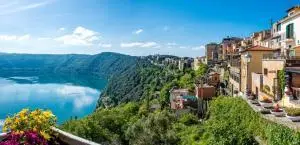
The Roman Castles, “invisible castles”
The Roman Castles, also known as the “invisible castles”, are historical places located near Rome, famous for their scenic beauty and gourmet food and wine tradition. Despite their rich history and natural attractions, these places often go unnoticed due to Rome’s extraordinary artistic wealth.
The very birth of Rome is linked to the events of Alba Longa, probably the current Castel Gandolfo, founded by Ascanio, son of Aeneas and Creusa in 1230 BC.
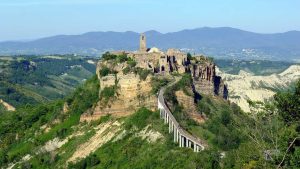
Civita di Bagnoregio, Caprarola, Bomarzo – DISCOVERING HIDDEN TREASURES OF ITALY
Italy is a country rich in hidden treasures and captivating destinations where history, art, and natural beauty come together in a unique and unforgettable experience. Among the lesser-known yet equally fascinating gems, Civita di Bagnoregio, Caprarola, and Bomarzo stand out. Let’s discover what makes these places so special.
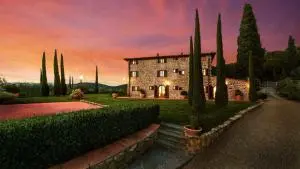
Wonders of Tuscany: a journey through Art, History and Food and Wine
Located in the heart of Italy, Tuscany is a true treasure to discover. Lush hills, luxurious vineyards, picturesque rural landscapes, historic villas, enchanting medieval cities and an atmosphere of refined timeless beauty have won the hearts of visitors from all over the world.
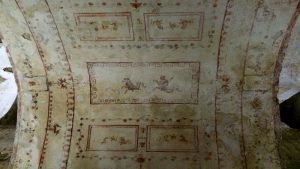
The Domus Aurea: a hidden masterpiece of Ancient Rome
Built by Emperor Nero in the 1st century AD, the Domus Aurea in Rome is an extraordinary monument that stands as a tangible symbol of the luxury and grandeur of ancient Roman civilization
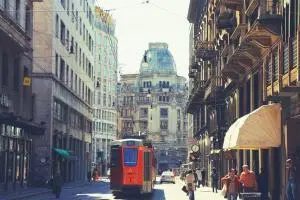
Guide of Milan for Newbies
Our Quick Guide to Milan for Beginners will accompany you in discovering the treasures of this fascinating and hectic metropolis, providing you with essential information on the main attractions.
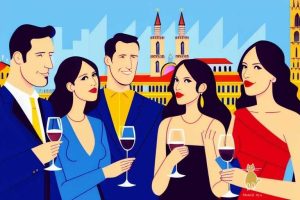
Milan: A food and wine experience not to be missed
Milan is much more than a fashion capital; it is also a top culinary destination. With its traditional cuisine, cosmopolitan culinary scene, food markets, and innovation, the city offers a complete eno-gastronomic experience.

Roman coast: a journey through history, sea and unique atmospheres
Discovering the Roman Coastline: A Journey through History, Sea, and Unique Atmospheres by Sarah Strol illustration by franco rea Roman
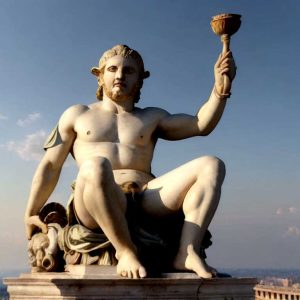
A Story of Rome
TRAVELS IN SPACETIME A Story of Rome It was a sweltering day in July, with the sun beating down on
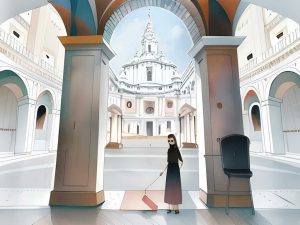
Discovering Rome’s “Hidden Treasures”
Discovering the “hidden treasures” of Rome Welcome to a fascinating journey through a less frequented Rome, different from the usual
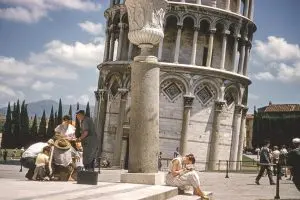
My Daily Excursions from Rome
“I am always looking for unforgettable experiences, and when I arrived in Rome, I was advised to participate in daily group or private excursions.”
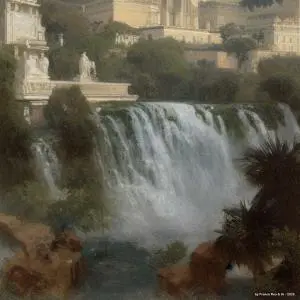
Impossible Rome
a gallery of images to you, created using artificial intelligence on the theme of “Impossible Rome”
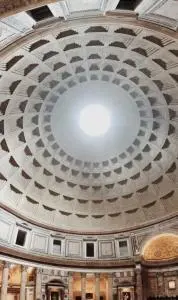
The Pantheon, great masterpiece of Roman architecture
Pantheon Contents The Pantheon Great masterpiece of Roman architecture. It is one of the ancient monuments best preserved in the
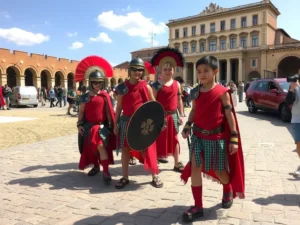
Fun Activities to do in Rome
for adults and children Fun and Unusual Activities to do in Rome Rome offers a myriad of opportunities to
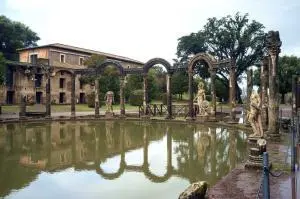
Villa Adriana in Tivoli, Rome
Villa Adriana – Tivoli, Rome The enormous complex of buildings of Villa Adriana in Tivoli, near Rome, was built (probably
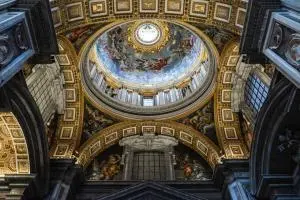
St Peter’s Basilica in Vatican State, Rome
The Basilica of St. Peter in the Vatican City The Basilica of St. Peter is in the heart of the
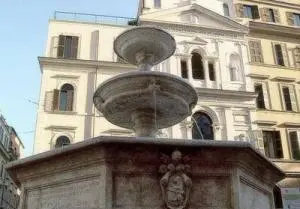
Rione Monti – the first quarter of Rome
Rione Monti Rome Index Monti, the first quarter of Rome The first quarter of Rome is “Monti” (mounts), so called as
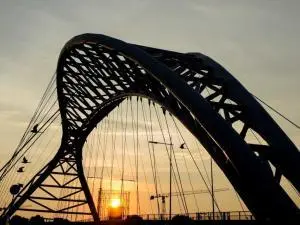
Places Contemporary Rome
The places of contemporary Rome Rome has never stopped adding new architectural layers to its topographic fabric, with works often
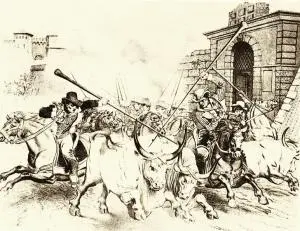
Eating in Rome
Eating in Rome! Eating like a God in Rome, Roman food’s survival guide! Index Eating in Rome “Please, recommend us
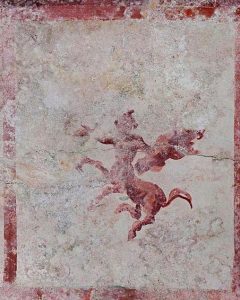
Why visit Rome
If you love traveling to discover unique places in the world, you must absolutely visit Rome!
